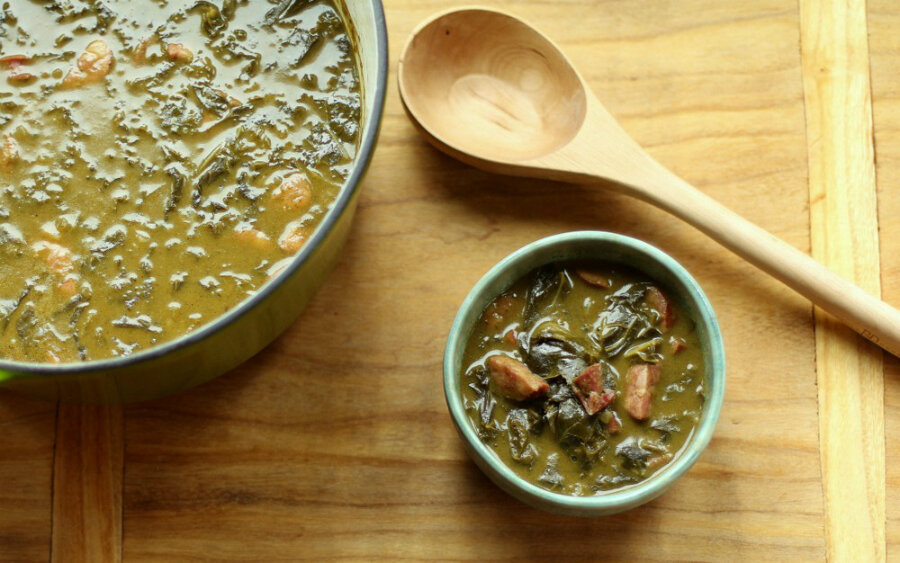Gumbo Z’Herbes
Loading...
Gumbo Z’Herbes, or green gumbo, is a very traditional Creole dish that you do not find all that often. The magnificent Leah Chase at Dooky Chase’s Restaurant is famous for hers, and she serves it primarily the traditional way – on Holy Thursday (before Good Friday). Gumbo Z’herbes is said to bring luck and strengthen the body, and that for each type of green you put in the pot, you will make one new friend in the coming year. The traditional number seems to be nine, with eleven greens being a real bonus, and odd numbers are said to bring even more luck.
I have only had professionally made Gumbo Z’Herbes once in new Orleans, but it is a tradition and a dish that has always intrigued me, so I set out to do some research. I read recipes I found in some old Louisiana cookbooks and online. And the variations are endless. So I took all that information onboard and created this recipe. I generally don’t use as many as nine greens, because I can’t usually track that many down. And some of the recipes used very regional ingredients like pickled pork that I just don’t have access to. Some versions take all day to prepare and cook, some take shortcuts. Some have up to seven different kinds of meat, from pork shoulder to boudin while some insist this should be a vegetarian dish for lent. I am not claiming this is the definitive version of Gumbo Z’Herbes, but it’s mine.
Though traditionally a dish for Lent, I think it is perfect for New Years Day, when eating greens is said to bring prosperity and eating pork is said to be a symbol of progress in the New Year. I say the more greens and pork the better!
Gumbo Z’Herbes
Serves 6
3 pounds of mixed greens: Mustard greens, collard greens, turnip greens, kale, spinach, flat leaf parsley, watercress, chard, dandelion (see note)
1 cup vegetable oil
1 cup all-purpose flour
2 cups finely diced yellow onion (about 1 onion)
1 cup finely diced green bell pepper (about 1 pepper)
1 cup finely diced celery (about 2 stalks)
1 tablespoon Cajun seasoning (I use Tony Chachere’s)
1 ham hock
10 cups hot water
1 pound Andouille sausage
1. Strip any thick stalks from the greens (particularly collards, mustard, turnip and kale) and place all the greens in a sink or large bowl full of water. Swish them around a couple of times and let them soak about 5 minutes. Lift the greens out of the water into a large colander. Dirt and silt from the greens will settle at the bottom of the sink, so gently lift them out to prevent the dirt getting back on the greens. Shake the greens to drain. Chop piles of the greens into bite size pieces and return them to the colander.
2. Now we are going to make a roux. In a large (at least 7 quart) heavy pan (I like cast iron or enameled cast iron), heat the oil over medium high heat. Add the flour and stir until smooth and lump-free. Cook the roux, stirring frequently, until the color begins to darken. As it deepens, stir more frequently, then constantly, scraping the bottom and sides of the pan. As it darkens, it can burn quickly so pay attention. I use a heatproof spatula or a wooden spoon for my roux. When the roux has turned a deep brown, between the color of sweet tea and a good bourbon, after about 15 minutes, add the chopped onion, celery and bell pepper and stir well. Cook until the vegetables are soft, about 5 minutes. Add the creole seasoning. Now slowly pour in the hot water (hottest from the tap is fine, or bring some to a simmer in a pot), stirring constantly. The roux may appear to curdle or seize, but keep stirring, it will smooth out. Add the ham hock, then all the greens, a handful at a time, stirring them down to fit in the pot. Reduce the heat to medium low, cover the pot and simmer the gumbo for 1-1/2 hours.
3. Scoop about a third of the greens into a food processor or blender with a nice dose of potlikker, at least a cup, and puree until smooth. Return the pureed greens to the pot. Remove the ham hock and carefully pull the meat of the bones. If needed, chop it into bite-sized pieces and add back to the gumbo. Slice the andouille into thin half moons about 1/8 inch thick and add to the pot. Simmer, uncovered, for 30 minutes more.
4. Serve in big bowls. The gumbo on its own is a little soupy. Serve it over rice to soak up some of that potlikker if you’d like, or with nice hunks of French bread or cornbread to sop it up.
Notes: Head to a good Southern market, farmers market or an Asian grocery to track down all the greens. Many recipes use carrot tops as one of the greens, so if you can find those. Same goes for beet tops and radish tops. Green chard, cabbage, arugula and romaine will also work. Just weigh out 3 pounds.







